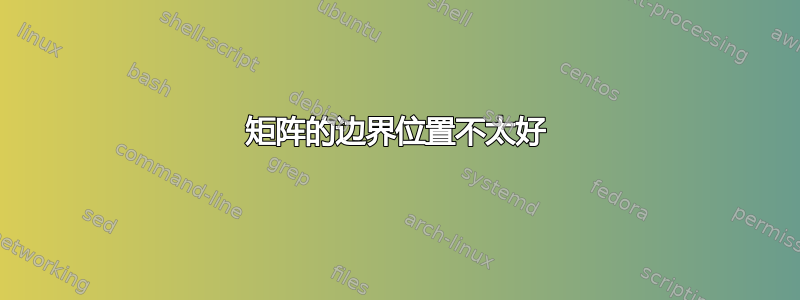
我有以下代码:
\documentclass{article}
\usepackage{tikz}
\usetikzlibrary{matrix}
\colorlet{mlightgray}{gray!20}
\begin{document}
\begin{tikzpicture}[cell/.style={rectangle,draw=black}, nodes in empty cells]
\matrix[
matrix of nodes,
row sep =-\pgflinewidth,
column sep = -\pgflinewidth,
nodes={anchor=center},
column 1/.style = {nodes={cell, minimum width=1cm, fill=mlightgray}},
column 2/.style = {nodes={cell, minimum width=2cm}},
column 3/.style = {nodes={cell, minimum width=2cm}},
row 1/.style={nodes={cell, minimum height=0.5, fill=mlightgray}},
row 2/.style={nodes={cell, minimum height=0.5}},
row 3/.style={nodes={cell, minimum height=0.5}},
row 4/.style={nodes={cell, minimum height=0.5}},
]
{ & 2 & 3 \\
1 & a & b \\
2 & c & d \\
3 & & e \\
};
\end{tikzpicture}
\end{document}
它产生这个矩阵:

似乎我已经使用了其他线程中提到的所有解决方案:pgflinewidth并且nodes={anchor=center}......但边界仍然不重叠......
不明白为什么图书馆让重叠变得如此困难,这是一个很明显的需求...有人可以帮忙吗?
另外,我只想始终使第一行和第一列具有mlightgray背景颜色,有没有办法避免重复row .../.style={nodes={cell, minimum height=0.5}}多次?
此外,与行不同,当我尝试将minimum width=2(而不是2cm)用作列时,效果并不好。为什么我必须为该宽度指定单位?
答案1
您可以使用text height和text depth键以便所有节点具有相同的大小。

代码:
\documentclass{article}
\usepackage{tikz}
\usetikzlibrary{matrix}
\colorlet{mlightgray}{gray!20}
\begin{document}
\begin{tikzpicture}[cell/.style={rectangle,draw=black}, nodes in empty cells]
\matrix[
matrix of nodes,
row sep =-\pgflinewidth,
column sep = -\pgflinewidth,
nodes={anchor=center,text height=2ex,text depth=0.25ex},
column 1/.style = {nodes={cell, minimum width=1cm, fill=mlightgray}},
column 2/.style = {nodes={cell, minimum width=2cm}},
column 3/.style = {nodes={cell, minimum width=2cm}},
row 1/.style={nodes={cell, minimum height=0.5, fill=mlightgray}},
row 2/.style={nodes={cell, minimum height=0.5}},
row 3/.style={nodes={cell, minimum height=0.5}},
row 4/.style={nodes={cell, minimum height=0.5}},
]
{ & 2 & 3 \\
1 & a & b \\
2 & c & d \\
3 & & e \\
};
\end{tikzpicture}
\end{document}
代码还可以进一步简化:
\documentclass{article}
\usepackage{tikz}
\usetikzlibrary{matrix}
\colorlet{mlightgray}{gray!20}
\begin{document}
\begin{tikzpicture}[cell/.style={rectangle,draw=black}, nodes in empty cells]
\matrix[
matrix of nodes,
row sep =-\pgflinewidth,
column sep = -\pgflinewidth,
nodes={anchor=center,text height=2ex,text depth=0.25ex,cell},
column 1/.style = {nodes={minimum width=1cm, fill=mlightgray}},
column 2/.style = {nodes={minimum width=2cm}},
column 3/.style = {nodes={minimum width=2cm}},
row 1/.style={nodes={fill=mlightgray}},
]
{ & 2 & 3 \\
1 & a & b \\
2 & c & d \\
3 & & e \\
};
\end{tikzpicture}
\end{document}
答案2
您还可以使用
execute at begin cell=\strut,
execute at empty cell={\node{\strut};},
并删除nodes in empty cells。此外,通过将节点定义为
nodes={cell,anchor=center,minimum width=2cm},
您可以进一步简化。请注意,当您使用minimum width它时需要一个长度参数,因此您必须指定单位,例如1cm或1in等,而不是简单地指定1。
\documentclass{article}
\usepackage{tikz}
\usetikzlibrary{matrix}
\colorlet{mlightgray}{gray!20}
\begin{document}
\begin{tikzpicture}[cell/.style={rectangle,draw}]
\matrix[
matrix of nodes,
row sep =-\pgflinewidth,
column sep = -\pgflinewidth,
execute at begin cell=\strut,
execute at empty cell={\node{\strut};},
nodes={cell,anchor=center,minimum width=2cm},
column 1/.style = {nodes={cell, minimum width=1cm, fill=mlightgray}},
% column 2/.style = {nodes={cell, minimum width=2cm}},
% column 3/.style = {nodes={cell, minimum width=2cm}},
row 1/.style={nodes={cell, fill=mlightgray}},
%row 2/.style={nodes={cell, minimum height=0.5}},
% row 3/.style={nodes={cell, minimum height=0.5}},
% row 4/.style={nodes={cell, minimum height=0.5}},
]
{ & 2 & 3 \\
1 & a & b \\
2 & c & d \\
3 & & e \\
};
\end{tikzpicture}
\end{document}



